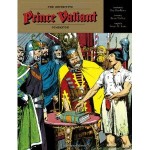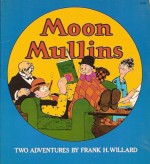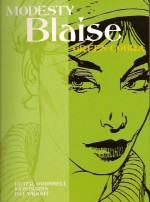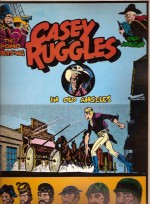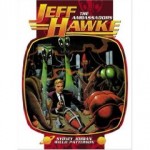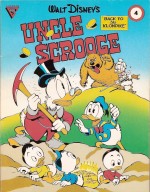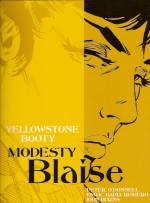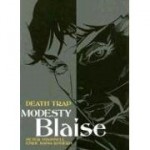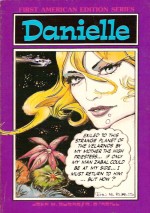
By John M. Burns & Richard O’Neill (Vertigo)
ISBN: 0-912277-23-8
If you indulge in the wonders of comics for any appreciable length of time you’ll increasingly find yourself becoming something of an apologist.
“I just like the artwork.â€
“They’ll be worth money one dayâ€
“It’s a metaphor for…â€
You get the idea. I often end up having to explain away situations and depictions that might seem racist, sexist or – worst of all – painfully naff, and at first glance, this book and its contents might easily confirm most if not all of those charges. But I’m not apologising and I urge you not to rush to judgements.
The prime reason for this is the illustrator. John M. Burns is an international star of comics but still remains largely unsung in his own country – which, considering the sheer breadth and quality of his output, is possibly the greatest compliment I can pay him. Britain has always been painfully ignorant of its comics heroes…
Born in Essex in 1938 he apprenticed at Doris White’s Link Studios in 1954 before moving on to Amalgamated Press where he worked on “Young Juvenile†titles such as Junior Express, Girl’s Crystal and School Friend, graduating to the luxurious photogravure mainstream comic Express Weekly a year later.
After National Service (we used to conscript our young men for two years’ military training in those hazy Cold War days – just in case…) which found him in the RAF and sent to Singapore he returned to comics in 1961, adapting Wuthering Heights for DC Thomson’s Diana and drawing Kelpie in Odhams revolutionary weekly Wham!
Spreading himself far and wide he followed Ron Embleton on Wrath of the Gods in Boy’s World and Eagle (scripted by Michael Moorcock – now there’s a strip crying out for collection), as well as The Fists of Danny Pike, Dolebusters and Roving Reporter. He was part of the inimitable and beloved team of artists who worked on Gerry Anderson’s licensed titles TV Century 21 and its sister magazines – he was particularly impressive on Space Family Robinson in Lady Penelope.
From 1965 he worked increasingly for newspapers beginning with The Tuckwells in The Sunday Citizen, The Seekers for The Daily Sketch (1966-1971), Danielle in the Evening News (1973-74), George and Lynne (1977-1984) and The Royals – the official strip biography of Prince Charles and Diana Spencer (1981) in The Sun and Modesty Blaise for The Evening Standard (see Modesty Blaise: Yellowstone Booty).
He revived Jane for the Daily Mirror (1985-1989) and has intermittently worked on many others. He was chosen to conclude Jim Edgar and Tony Weare’s incredible, long-running western strip Matt Marriot in 1977.
Burns’ TV related work is magnificent. He has worked on licensed series for Look-In, TV Action and Countdown illustrating the adventures of UFO, Mission Impossible, Tomorrow People, Bionic Woman, How the West Was Won and others. For Germany he drew the strip Julia (also know as Lilli) and worked with Martin Lodewijk on the fantasy series Zetari before in 1980 beginning his long association with the legendary British science fiction comic 2000AD, where he has – and continues to – work on Judge Dredd, Trueno, Nikolai Dante and his own Bendatti Vendetta.
He is also a regular adaptor of significant literary masterpieces, having already completed pictorial versions of Lorna Doone, Wuthering Heights and Jane Eyre.
1973 was the height of the much-maligned “Sexual Revolution†with women demanding equal rights, equal pay and fair treatment (and isn’t it great that they’ve got all those things now…). Contraception was becoming readily available, everywhere bras were burning, and men thought that sex wasn’t going to be so expensive anymore. It was a reactionary Male Chauvinist Pig’s Dream, and unrepentant old-school stand-up comedians were having a field day.
I’m not sure that the various editors of papers were supporters of the Women’s Lib movement, or simply found a great excuse to turn the industry’s long tradition of naked chicks in strips into something at least nominally hip, political and contemporary: I do know that a awful of new features with liberated, forceful women who nevertheless still had hunky take-charge boyfriends in tow appeared – but not for very long.
One of them was Danielle: at first glance a fantasy saga in the tradition of Garth, but as the saga unfolded, one that developed beyond its superficial beginnings. The strip launched on Monday, September 17th 1973, and introduced a willowy blonde heroine: a rebel against an oppressive regime, and one whose railing against the system had resulted in her banishment. Her crime? She had loved a man.
Now Danielle had returned to the planet Janus to overthrow her own mother, whose matriarchal dictatorship had kept men as subservient sex-slaves, and to rescue her truly beloved Zabal from the State Brothel he had been condemned to (stop sniggering).
Reversing many of the cherished trappings of Flash Gordon, Danielle fought monsters and militarists before she and Zabal escaped, using a magical Pendant of Power to leap into the chaos of time and space. From then on the pair roamed the universe like buff, unclad Doctor Who extras, first landing in futuristic Britain in ‘Master Plan’ where the previous situation is utterly reversed and women have been drugged into subservient submission and a highly commercialised male hegemony rules virtually unopposed.
When Zabal’s head is turned by freedom and testosterone-soaked male dominance he betrays Danielle until she joins the all-female resistance and helps overthrow the Masters. Reunited but not quite so trusting anymore they are then whisked by the Pendant to ‘The Dump’ an intergalactic penal colony, where she is the only woman, before the space eddies tear them apart and Zabal is lost…
In ‘Dark Genesis’ Danielle lands on a desolate world where the rejects of a super-alien’s genetics program try to stop her from becoming their creator’s latest stock-breeder, but after defeating the alien with common sense the hapless voyager materialises at a ‘Black Sabbath’ in Edinburgh in 1660. Mistaken for a demon she finds herself at the mercy of Puritan witch-finders and corrupt, debased officers of Cromwell’s New Model Army…
Appalling as these summations sound, Richard O’Neill’s scripts are a wry and canny counterpoint to the strident zeitgeist of the times. Brought in to overhaul Burns’ initial proposal, the ex-TV 21 editor managed to impose a studied balance to what was always intended to be a slight, escapist, lad-ish girly-strip with lots of ogle-worthy nudity and loads of fantasy action.
With deliberate overtones of H.P. Lovecraft and Philip José Farmer, the military historian added a knowing lightness to the proceedings which, married to Burn’s imagination and incredible line-work, resulted in a delight of self-deprecatory storytelling which is far, far from the exploitative, pandering lip-service it might first seem to be.
However it couldn’t save the feature. ‘Superstar’, the last story in this slim black and white volume, deviates from the established format as Danielle lands on a Hollywood film set in 1930. Quickly co-opted by a zany movie director she becomes a reluctant rising star before being reunited with Zabal who has been marooned on Earth for decades. Roaring along at a rather brisk pace and played strictly for gentle laughs, this final tale abruptly ended Danielle’s cosmic capers on September 14th 1974. Not included in this book is her 54 day revival from 1978, but I suspect that’s for the best…
Heavy-handed at first glance but stunningly beautiful to look upon; this is a series with a lot to say about the times it came from and perhaps one that might finally find a welcoming readership in these oh-so-perfect modern days.
© 1984 Associated Newspapers Group. All Rights Reserved.
